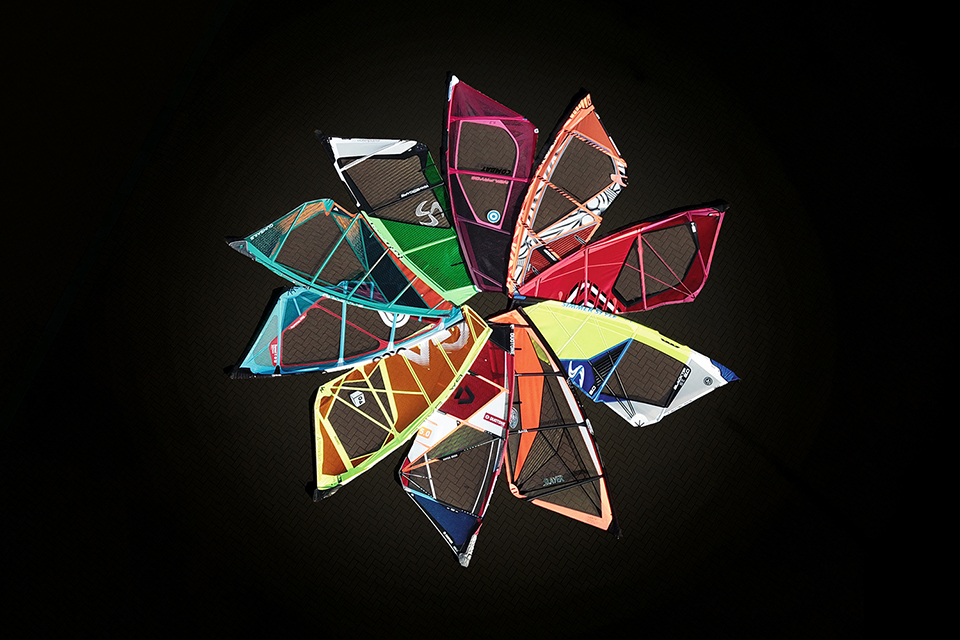FIVE STARS
5.0M WAVE SAIL TEST 2019
Test Editor Tris Best // Second Testers Maurin Rottenwalter, Joe North, Scott Stallman, Darren Amor & Tom Wells
Photos Bryony Webb // Test location Ringstead, Gwithian & Rhosneigr.
En route to a well-known West Country wave riding hotspot for the wave tests, a question was posed to the team to identify the qualities they all looked for in their wave sails. To add coal and stoke the fire, they were then asked to rank and prioritise those qualities. So what, at point of conception, was originally expected to be a quick two minute conversation, where all would be in agreement before moving on, quickly morphed into a lengthy hour-long debate, where several strong characters eventually had to agree to disagree. Well, it made the journey go much faster at least!
This test was originally published in the November/December 2018 issue.
So, at the risk of reigniting the dispute when the team next assemble, here’s a very succinct rehash of how the conversation went, starting with the points that were agreed upon! Everyone subscribed to the idea that power was key – the power to get going early, the power to drive positively into turns, and / or hit ramps with intent. Handling was next, the sail needing to feel compact, comfortable and balanced. And no one disagreed that there is genuine necessity for range (particularly in typical UK conditions) – the grunt to make the most of marginal winds, and the control to handle the harshest. The catalyst for the big discussion, then, was to do with the power’s delivery and the manner of the feedback through the hands. Some were adamant that soft, smooth and neutral was the way forward, whilst others demanded it be sharp, fast and direct. The reality is that there certainly isn’t a right or wrong answer here – it is solely down to rider preference. So before you delve any further into the test, it would be prudent for you to acknowledge which camp you fit into.
FINDINGS
Having conducted the test and tried these ten contenders in a variety of conditions and wind strengths, it is clear that the discussion rages on amongst the brands as well! Almost all of them have matured and merged towards similar moderate luff curves to one another. And out of the ten brands on test here, a strong percentage of them have evolved their designs to seek softer power deliveries, with a clear goal of ultimately becoming super neutral and light in transition. Balanced power comes from the main panels (or belly) of the sail, so many have sought to free this up, letting it expand and swell automatically as a gust hits, before retracting as pressure is released and bestowing that utopian on-off nature. This has been achieved by employing various methods, the most visibly obvious being the option to shorten the main batten to 3/4 length (GA Sails and Severne). Duotone and Neil Pryde, on the other hand, have opted to expand the distance between the two lower battens to allow movement in the draft at lower pressures, whilst a more tried and tested method used by many is the use of a Dacron luff panel to allow natural progressive movement. Simmer have gone a step further and split their luff panel between Dacron in the lower panel and x-ply in the upper, providing the motion in the draft, yet limiting creep and any decay in stability. And that is of course the conundrum – striking the right balance between extending power in the lower wind limit without impairing stability at the top end (a real hurdle for four batten sails in the past). Countermeasures include using stretch tendons radiating from the clew, mini-battens sewn at intervals along the length of the trailing edge and definite steps down the outline of the leech, particularly between the main batten and clew.
Another real decision that splits the field is whether to use seam shaping or batten rotation in their sail, to strike the right balance between power and stability. Pushing shape into a sail’s profile at rest ensures bottom end performance and structural integrity, but at the expense of never really going entirely neutral in the hands. Yet relying solely on batten rotation for stability often means that light wind grunt and response is missing, the sail requiring more input from the wind before it really starts to generate power. There are many ways in which to solve the same problem, and each designer has their preferred method. Sail design continues to evolve as technologies advance, and many of these sails manifest the passion and enthusiasm their respective lofts have for the sport and the wave discipline in particular.
SUMMARY
This is the first opportunity we have had to test a Witchcraft sail, and have to say we were mightily impressed with the Slayer’s vast tuning range, employing both rotation and seam shaping to significantly alter its character between its various ‘sets’. The GA Sails Manic is also incredibly tuneable, never going completely neutral as you would expect of a five batten sail, but re-rig it with the 3/4 length batten and enjoy a blissful light-wind performance extension. The other sail offering the same solution is the S1 from Severne – probably the surprise package of the test. Light, neutral backhand pressure has become a hallmark of Severne’s sails … yet the full-bodied power this little four batten 4.8m produces in marginal winds was eye opening. The natural range award goes to the Simmer Blacktip, striking just the right balance between soft easy delivery and direct handling to appeal to all who tried it. The Combat from Neil Pryde has definitely become softer for the new season too, without losing its stand out efficiency, whilst the Banzai X Pro from Goya comes from the other end of the scale and is every bit as sharp and precise as we remember from years past. The RRD, Loftsails and Gunsails all offer fantastic control for the most challenging conditions, the Vogue Pro taking a little longer to power up and possessing a more direct nature, whereas the Wavescape has a beautiful on-off manner to make the flow between the points of a wave ride as smooth and fluid as possible. The Horizon feels more freemove, thriving on a locked in blasting style, enjoying the occasional drop into a wave. That leaves the Duotone Super Hero – a design that has been refined over a number of years but has really come of age in 2019, offering stunning all-round performance, in both appeal and application.
THE LINE UP


